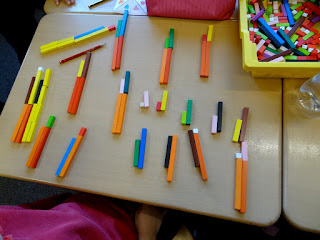The Cuisenaire Company
has republished Madeleine Goutard's
Mathematics and Children, and I've been reading my copy.
Here's something. Back in the 1960s she was training teachers in the Province of Quebec, promoting the use of Cuisenaire rods. And yet her first chapter begins with
a warning not to use them too much:
“It is generally agreed that concrete experience must be the foundation of mathematics learning. When children find it difficult to understand arithmetic it is at once suggested that this is because it is too abstract; for small children the study is then simply reduced to the counting of objects. It seems to me that there has perhaps been too great a tendency to make things concrete and that perhaps the difficulties children experience spring from the fact that they are kept too much at the concrete level and are forced to use too empirical a mode of thought.” (p2, my emphasis)
What kind of abstraction is she looking for then? Exactly the kind that
Connecting Arithmetic to Algebra is recommending: looking for general patterns in the way simple arithmetic works.
"I find it of limited value to ask children a large number of definite, restricted questions whose answers they obtain through manipulation of the rods. On the other hand, I find it most profitable to start with vast questions which can be seen in a number of ways and which permit a continuous analysis of the dynamics involved. This is why I shall consider here families of equivalent additions, of equivalent subtractions, and of equivalent products and quotients." (p3)
And as well as having a clear idea of the kinds of areas that are fruitful to investigate, Goutard had a very strong view of the role of the teacher.
"The teacher is not the person who teaches him what he does not know. He is the one who reveals the child to himself by making him more conscious of, and more creative with his own mind. The parents of the little girl of six who was using the Cuisenaire rods at school marveled at her knowledge and asked her: 'Tell us how the teacher teaches you all this', to which the little girl replied: The teacher teaches us nothing. We find everything out for ourselves.'
It is evidently very difficult to give the child so complete an impression of non-presence, and to convince him that he alone is the artisan of his own education, but this is the way in which free and conquering minds are formed." (p184)
You can see that Goutard has an abstract way of writing, quite philosophical and psychological. I find I want to ask her, "How did the teacher teach her?? Yes, I know she stood back and gave her space. But how did she set up her sessions? How do you reconcile the seeming oxymoron of having the student genuinely following their own way, and at the same time having the teacher directing them towards the vast questions? How, not just in general terms, but how does a lesson go? What do you say? What do you do?" I want to see dialogues, with just a little bit of analysis, like you find in
Connecting Arithmetic to Algebra. I want to get a feel for actual lessons.
But we haven't got that.
Luckily, all is not lost. If we don't have a clear roadmap, we've got a clear destination and a bearing. And I'm getting a more and more clear idea about the details. It helps to have colleagues like
Caroline Ainsworth bringing Goutard's ideas to life. And #MTBoS collagues like
Tracy Johnston Zager,
Kristin Gray,
Mike Flynn,
Elham Kazemi and
Kassia Wedekind and many others who while they understand the vital importance of the agency of students, also seek ways for them to connect with the 'vast questions'.
I think the square can be circled.
Our beginnings are small:
After which we go off to write our own ones in our journals.
The next step is to take one of these, and focus on it. (For example, I find the relation between the five threes and Jinmin's triangle number way of expressing it worth following. Worth getting the rods out and investigating.) And then you're listening out for the generalisation, the claim. Up on the claims board. Do you agree with it? Then how would you explain it? Show it with pictures, words, equations, a story...
I hope we can do our bit to reanimate Goutard's brilliant philosophy. I hope too to capture a few of the moments while we're at it, and perhaps share them with you.
_____________________
Today we got our "Mathematical Claims" board started. To get the ball rolling I showed an image and asked for remarks. After the obvious features, I asked if anyone could say something more general. "What does general mean?" someone asked. We talked about that a little and then Tibo said:
to which Jinmin adedd:
These ones came a bit too quick and easily; they'd talked about them with teachers before. But they went up on the board to get the idea going. I'm looking forward to claims that come out of a more immersive experience of trying things out, reflection, and talking things through, ideas that are a little more hard-won, (and hard-defended).













